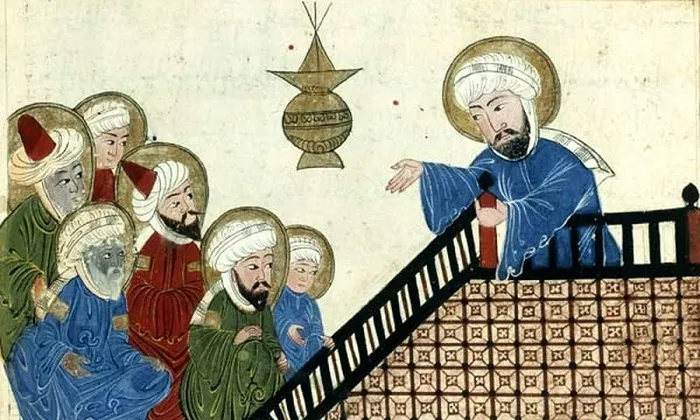Who was Muhammad?
Muhammad, whose full name was Abu al-Qasim Muhammad ibn 'Abd Allah ibn 'Abd al-Muttalib ibn Hashim, was founder of Islamic religion and civilization . Born in 571 AD, in the city of Mecca, located on the Arabian Peninsula, Muhammad belonged to the tribe of the Quraysh , specifically to the Hashemite clan, also known by the name Banu Hashim, as the orientalist David Samuel Margoliouth explains in his work Muhammad and the Rise of Islam |1| :
“Muhammad was the son of parents born in Mecca. His names are said to be Abdallah (Servant of Allah) and Aminah (The Safe, or Protected One). His mother belonged to the Banu Zuhrah, and his father was the son of Abd al-Muttalib, of the clan called Banu Hashim. It is certain that the father of the future Prophet died before his son was born, it is said, while visiting Yathrib, later known as Medina. The mother did not long outlive her husband, and her grave, as some claim, is at Abwa, a place halfway between Mecca and Medina, where, some fifty years later, her bones were in danger of being exhumed. ”.

How orphaned too soon , Muhammad was raised by his uncle Abu Talib (also of the Banu Hashim clan), from whom he received formal education and learned the trade of trading spices in the trans-Saharan camel caravans.
It was as a caravan leader that, in 595, Muhammad met a wealthy widow, also a Hashemite, named Khadijha , going to work for her. After demonstrating great skill in managing Khadijha's affairs, Muhammad and his widow, by mutual agreement, were married. This marriage substantially transformed the life of the then merchant, who did not have a great fortune at the time.
See also: Islamic fundamentalism – branch of religion in which believers literally interpret the Koran
Allah and the hanifs
The fact is that, at the same time that Muhammad began his new life with Khadijha, he also began to experience the first religious manifestations that would define the Muslim religion. It is important to emphasize that, even before Islam established itself as a religion, in Mecca and other regions of Arabia, there was a confluence of creeds, both pagan, polytheistic, Jewish and Christian. In addition to Jewish and Christian monotheism, there was also a third group, the hanifs , born amidst the pagan hodgepodge of typically Arab groups.
As the historian Daniel-Rops points out, in his work The Church of Barbarian Times |2| :
“In the time of Muhammad, new trends were emerging within this traditional polytheism:the influence of Jewish colonies and heretical Christians in the Aramean world, to the north, and from Ethiopia to the south, he called the best spirits to a higher religion. Particular deities continued to be honored, but one of them began to predominate over the others:Allah, recognized as “the greatest” – Allah akbar. In addition, there were already some monotheists – neither Jews nor Christians – called hanifs. ”
Muhammad's parents and many members of the Hashemite clan worshiped Allah , but it was Mohammed who, in the early years of the 7th century, began to systematize properly Islamic belief. Muslim tradition reports that Muhammad began to have progressive revelations given by God (Allah) through the Angel Gabriel .
These revelations would have given Muhammad the authority to be the Prophet of Allah , that is, the one who would have the mission to correct the distortions that Jews and Christians would have made of the past revelations, and the responsibility to remove the polytheistic Arab tribes from the “age of ignorance” and convert them to Islam.
See also: Islamic Sufism – set of mystical practices developed by Islamic sages
Escape to Yatreb and military clashes with Mecca
Mohammed began by converting those closest to him, like his wife, father-in-law, cousins, etc. However, their monotheistic radicalization began to have effects on the social and economic dynamics of the Quraysh tribe . Other Meccan clans began to confront and persecute Muhammad and his group of converts.
With the death of his uncle and, later, his first wife, Khadijah, who died in 619, Muhammad decided to accept the support and hospitality of families living in the city at the time. from Yatreb , to which he migrated in 622. This migration, or flight, became known as the Hegira .
In Yatreb, Muhammad gained more adherents to Islam, so the city became his main stronghold and also his headquarters, to the point that the city have its name changed to Medina (“the City”, or “City of the Prophet”). From Medina, Muhammad went on to fight successive battles against Mecca.
Religious preaching became intertwined with war and the prospect of conquest. Two of the main battles fought by this first group of Muslims were in the cities of Badr , at 624, and from Ohod , in 625. They won the first and lost the second. The main enemy Muhammad's Meccan at this time was Abu Sufayan .
Sufayan, at 627, attempted to besiege Medina , but the Muslim warriors managed to repel a troop of about 10,000 Meccans. The following year, there was a brief truce with the permission given to Muhammad by the Meccans to go on pilgrimage to his hometown. In 629, Muhammad gathered his fighters and besieged Mecca. Battles for dominance over the city lasted until January 630, when the Meccan resistance was subdued.
The rule of Mecca was the first step in the great and rapid Islamic expansion that would be seen in the following years. Muhammad died two years after subjugating his hometown. His death sparked disputes successories that would later define the Sunni groups and Shia , characteristics of the development of Islam.
Notes
| 1| MARGOLIOUTH, David Samuel. Mohammed and the Rise of Islam . trans. Sergio Lamarao. Rio de Janeiro:Counterpoint, 2012.p. 53.
| 2| DANIEL-ROPS. The Church of the Barbarian Times. trans. Emeric da Gama. Quadrant:São Paulo, 1991. p. 331.
